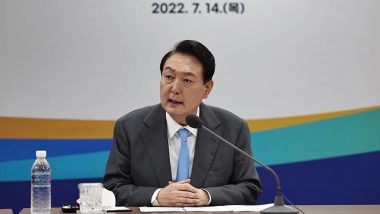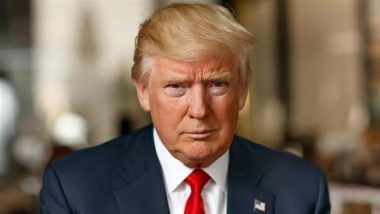Hong Kong, Dec 11 (ANI): After President Donald Trump announced on 20 October that the USA was considering pulling out of the Intermediate-Range Nuclear Forces (INF) Treaty -- a voluntary agreement between Russia and the USA signed by Ronald Reagan and Mikhail Gorbachev -- the Chinese Foreign Ministry warned of "many negative effects".
Foreign Ministry spokeswoman Hua Chunying commented: "We hope that the relevant country can cherish the hard-won outcomes achieved over the years, prudently and properly handle the issues related to the treaty through dialogue and consultation, and think twice before withdrawing."
She added: "China has always adhered to the defensive nature of its national defence policy and protects its own state interests. China will not tolerate any blackmail from any country."
These were interesting comments from a country that is not party to the INF Treaty. Yet Beijing is right to weigh in on the issue, because any abandonment of the treaty is extremely pertinent to China.
Indeed, Adam Ni, a visiting fellow at the Strategic and Defence Studies Centre of the Australian National University in Canberra, confirmed to ANI that because China is not a signatory to the INF Treaty, this has enabled it to "rapidly develop its conventional and nuclear missile forces for decades".
In China the People's Liberation Army (PLA) has taken full advantage of Moscow's and Washington's voluntary self-restrictions by creating an enormous arsenal of short-range (SRBM), medium-range (MRBM) and intermediate-range ballistic missiles (IRBM). Among these classes are the PLA Rocket Force's (PLARF) DF-11, DF-15, DF-16, DF-21 and DF-26 missile.
The DF-21 family includes the DF-21D anti-ship ballistic missile, while the DF-26 can carry either conventional or nuclear warheads and it puts American military bases as far away as Guam within easy reach.
Under no illusions, Ni warned that "Russia is a sideshow" and that the "real action" is against China in terms of Trump's proposed withdrawal from the INF Treaty.
He noted that SRBMs to IRBMs "are key tools for China to raise the risk of US military intervention in Asia against China, such as in a Taiwan scenario or over the South China Sea". Both of these are hotspots and the focal point for Sino-US tensions, with the PLARF's missile arsenal posing a serious disincentive for the US military to do anything too provocative.
The Australia-based academic elaborated, "This means that China is placed at an advantage in Asia-Pacific vis-a-vis the Americans when it comes to intermediate-range missiles. The US, bound by the treaty, is unable to deploy intermediate-range nuclear and conventional ground-launched ballistic and cruise missiles. China's anti-access/area denial (A2/AD) strategy is made more effective for the lack of equivalent US missile forces to hold Chinese targets at risk."
Secretary of State Mike Pompeo said on December 4, that it would give Moscow 60 days to desist from any testing that it deems in breach of the treaty. The USA is particularly concerned about the 2,500km-range SSC-8 cruise missile, believed to be a ground-launched version of the Kalibr weapon, and the RS-26 ballistic missile. Although the latter is supposed to be an intercontinental ballistic missile (ICBM) with a beyond-5,500km range, it has been test-fired at ranges of around 2,000km.
Trump had noted, "Unless Russia comes to us and China comes to us and they all come to us and say, 'Let's really get smart and let's none of us develop those weapons.' But if Russia's doing it and if China's doing it and we're adhering to the agreement, that's unacceptable."
The INF Treaty was signed in 1987, preventing the USA and Russia from possessing, producing or testing nuclear-tipped ballistic missiles and conventional cruise missiles with a range of anywhere from 500km to 5,500km, which encompasses short ranges to intermediate ranges.
Admiral Harry Harris, former head of the US military's Pacific Command and now the US ambassador to South Korea, claimed in a testimony that the PLARF has "the largest and most diverse missile force in the world, with an inventory of more than 2,000 ballistic and cruise missiles". He alleged that 95% of these missiles would violate INF Treaty regulations if China had been a signatory.
Ni outlined for ANI the broader background: "I think the key reason for a potential US withdraw would be Washington's view of strategic competition in the Asia-Pacific against China. For many years now, US strategists and policymakers have argued that the INF Treaty hinders US military strategy against China in the Asia-Pacific."
"Rising US-China strategic competition and the rapid modernisation of Chinese military capabilities gives added impetus for the US to rethink the efficacy of the INF Treaty," Ni shared.
Beijing knows that an American pullout from the treaty will directly impinge upon the current military balance in Asia. Ni pointed out the impact: "The key implication for China.is that its A2/AD strategy would be less effective, and that its military power projection would be constrained within the disadvantageous confines of the First Island Chain."
Apart from brusque statements from the Foreign Ministry, what other reactions might we expect from China? Gazing into his crystal ball, Ni predicted: "Beijing is likely to respond to potential US deployments through accelerating the modernization of capabilities required to ensure local superiority, such as missile and information warfare systems. If that happens, we should expect a marked rise in China's conventional missile arsenal."
Deeper questions also need to be asked what the USA gains from deliberately spurning the INF Treaty. For example, is Washington DC likely to introduce new types of short- and intermediate-range missiles that could target China?
Certainly, new missiles that possess different ranges gives the US more regional strike options, but it already has numerous capabilities at its disposal from submarines, warships and aircraft. The Tomahawk cruise missile and AGM-86 Air-Launched Cruise Missile (ALCM) are already available, with the latter soon be replaced by the Long Range Stand Off (LRSO) Weapon.
Developing new ballistic missiles is an expensive business, although the US has the knowhow and military industry to rapidly develop and produce such missiles that were formerly banned.
An advantage of potentially deploying such land-based missile systems in Asia, to Guam for example, would reduce US reliance on major naval assets such as aircraft carriers and submarines in a US Navy fleet that is stretched thin. "This would also add to the US ability to hold targets in China and in the region at risk,' Ni explained.
He elaborated: "If the USA withdraws, we are likely to see moves to deploy intermediate-range land-based missile systems to Asia. This will take many years to pan out. Negotiations between the US and its allies for potential deployments of land-based missile systems would be required. Potential candidates include Japan, the Philippines, Australia and Guam."
At this point, however, there may be little stomach in countries around Asia to house US ballistic missiles, especially when China can already blanket these territories with its own arsenal of weapons.
The Philippines, for example, is in China's pocket, and such a thought would be anathema to the current president. South Korea has already tasted the ire of China after it agreed to allow the US Army to deploy a Terminal High-Altitude Area Defense (THAAD) battery to its territory. That permission resulted in a bitter feud that hit South Korean businesses hard. Seoul is concerned almost exclusively about the North Korean missile threat, so any decision to base American ballistic missiles there is a nonstarter.
There are two countries that could benefit from regional deployments of new US missiles, however, and those are Taiwan and Japan. Ni elaborated, "If potential deployments end up in Japan, then China is going to find it harder to coerce Japan without an added risk of escalation. This is also an opportunity to renew and deepen the US-Japan alliance in the face of China's rise."
However, Japan has had a very strong anti-pacifist bent since the end of World War II, and there would be massive anger amongst the populace about any efforts to base new nuclear weapons on the island nation.
"For Taiwan, it would mean that the USA would have a cheaper and less risky tool at its disposal to respond against China in a Taiwan scenario. It would no longer have to risk its forces directly, but punish potential Chinese aggression through missile strikes against the Chinese mainland," Ni said.
Interestingly, Asian allies of the US have remained largely silent on the issue of the INF Treaty. The sudden announcement by Trump would not have helped the levels of trust that some Asian countries have in the US administration.
The bottom line is that any American move to deploy new ground-based ballistic missiles in Asia would be hugely contentious and would result in acerbic pushback from China at levels hitherto unseen.
Indeed, some argue that Washington is therefore making a mistake by threatening to leave the INF Treaty. Not only will a withdrawal enable Russia to saturate Europe with missiles it has already developed, but it will also gain few new opportunities for itself in the Asian theatre.
To date, there has been no indication that the USA will try to create a replacement treaty for the INF Treaty, one that would include China, for instance. It is unimaginable that Beijing would willingly submit to any such treaty, especially when it has worked so hard to build up an advantage in these categories of missiles. It poses a considerable threat to US naval shipping, so there is no conceivable reason why Beijing would throw that away when the USA has no bargaining power over it.
The final question to ask is what impact a US withdrawal from the treaty will have in the short term. The Australian National University fellow concluded: "I think the US force posture will improve in Asia in the short term if such deployments were to happen. This, however, would drive Chinese renewed effort at pulling back the advantage."
However, major question marks remain over what advantage intermediate-range nuclear forces would give the USA in Asia, especially when it does not really have anywhere to put them. It might therefore only result in more money being poured into missile programs that are not needed, at the expense of other more important areas of defence spending. (ANI)
(This is an unedited and auto-generated story from Syndicated News feed, LatestLY Staff may not have modified or edited the content body)













 Quickly
Quickly





















